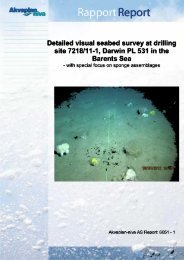A study of the priority substances of the Water Framework Directive ...
A study of the priority substances of the Water Framework Directive ...
A study of the priority substances of the Water Framework Directive ...
You also want an ePaper? Increase the reach of your titles
YUMPU automatically turns print PDFs into web optimized ePapers that Google loves.
27 Pentachlorophenol/PCP<br />
� Pentachlorophenol is probably carcinogenic, it<br />
may contain dioxins and wood preserved with<br />
PCP may form dioxins if incinerated.<br />
� The main use <strong>of</strong> PCP is wood treatment.<br />
� Use <strong>of</strong> PCP is strictly regulated in Norway.<br />
� Pentachlorophenol should be screened at<br />
localities where it is possible to find high levels<br />
<strong>of</strong> pollution.<br />
Production and use<br />
Globally, main use <strong>of</strong> PCP is and has been treatment<br />
<strong>of</strong> wood as a sap stain control, wood preservative<br />
(used on wooden pallets) and as a surface<br />
biocide for masonry and for preservation <strong>of</strong><br />
textiles including heavy duty fibres. In Norway,<br />
PCP has been used in <strong>the</strong> paper industry, and as<br />
wood preservative. Import is registered by <strong>the</strong><br />
Norwegian Food Control Authority between<br />
1974 and 1978. Norwegian emissions are to be<br />
phased out by 2005. There are no direct emissions<br />
today, but PCP may be present in imported<br />
products such as textiles, lea<strong>the</strong>r and wood.<br />
Emissions, discharges,<br />
distribution and hot-spots<br />
Use <strong>of</strong> PCP in Norway is regulated; chemicals<br />
or mixtures <strong>of</strong> chemicals containing more than<br />
0.1 percent PCP are banned. A report commissioned<br />
by Miljøministeriet in Denmark in 2004<br />
stated that 1.2 million tons PCP treated wood<br />
were still in use in Denmark, especially in pallets<br />
from Sou<strong>the</strong>rn Europe and in old building<br />
materials.<br />
Monitoring<br />
PCP has been investigated on three geographical<br />
locations in Norway (Lågendeltaet in Oppland,<br />
Mjøsa and Selbusjøen).<br />
Fresh water sediment<br />
The three investigations in Lågendeltaet in<br />
Oppland, Mjøsa and Selbusjøen gave very low<br />
or no concentrations <strong>of</strong> PCP. In Selbusjøen use<br />
<strong>of</strong> PCP for wood treatment is known until<br />
1974, but nothing was found.<br />
Need for fur<strong>the</strong>r screening and monitoring<br />
PCP in construction wood and pallets are monitored<br />
in Denmark. Incineration <strong>of</strong> PCP wood<br />
may cause dioxin formation when incinerated.<br />
FACTS<br />
Cas no.: 87-86-5<br />
pentachlorophenol/PCP ::::::::::..<br />
Synonyms: PCP, penta, 2,3,4,5,6-pentachlorophenol,<br />
chlorophen, penchlorol<br />
Properties: White to dark brown crystalline solid with<br />
a phenolic odour.<br />
Toxic effects: Commercial pentachlorophenol may<br />
contain dioxins, thus <strong>the</strong> toxicity varies according to<br />
this. PCP is considered toxic; LD50 oral rat is from 27<br />
to 211 mg/kg. Inhalation <strong>of</strong> PCP is considered very<br />
toxic (ClassLab), LC50 inhalation rat is from 0,2 to 2,1<br />
mg/l. PCP is irritant to human skin, throat and eyes<br />
and highly to very highly toxic to many species <strong>of</strong><br />
fish; LC50 is 52 µg/L/96 h in rainbow trout<br />
(Oncorhynchus mykiss). The substance is also strongly<br />
toxic to plants. There are also reported chronic<br />
effects; PCP may be mutagenic and is probably a<br />
human carcinogen (EXTOXNET, HSDB).<br />
Log Kow: 3,32<br />
Persistence: In soil, field half-lives <strong>of</strong> weeks to months<br />
are reported, slower in cold environment. For vapour<br />
in air half life is 29 days (photochemically) Weeks to<br />
months in sediments, as little as no degradation in<br />
anaerobic conditions. EXTOXNET, HSDB). DT50 in aerobic<br />
aquatic circumstances, incl. sediment, is 4 days.<br />
BCF values from approximately 100 to 1000 (HSDB)<br />
indicates low potential for bioaccumulation<br />
<strong>Water</strong> solubility: 14 mg/l<br />
Molecular formula: C 6 -H-Cl 5 -O<br />
Metabolites: Tetra- and tri-chlorohydroquinone (in<br />
rat) pentachloroanisole (in fungi), tetrachlorohydroquinone<br />
and pentachlorophenol glucuronide (found<br />
in human urine).<br />
PCP in wood should be screened, in order to<br />
asses <strong>the</strong> risk <strong>of</strong> dioxin emissions from incineration<br />
<strong>of</strong> pallets and construction wood, as bi<strong>of</strong>uel<br />
is excluded from waste incineration regulations,<br />
and does not have to use filters to clean emissions.<br />
PCP concentrations in Denmark are connected<br />
to pallets and to production <strong>of</strong> building<br />
materials such as windows. There is a need for<br />
screening <strong>of</strong> PCP in Norway.<br />
Localities for fur<strong>the</strong>r screening and monitoring<br />
This screening should be done on places where<br />
PCP pollution should be expected, such as in<br />
A <strong>study</strong> <strong>of</strong> <strong>the</strong> <strong>priority</strong> <strong>substances</strong> <strong>of</strong> <strong>the</strong> <strong>Water</strong> <strong>Framework</strong> <strong>Directive</strong><br />
TA-2140/2005<br />
65:::..

















